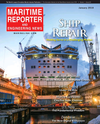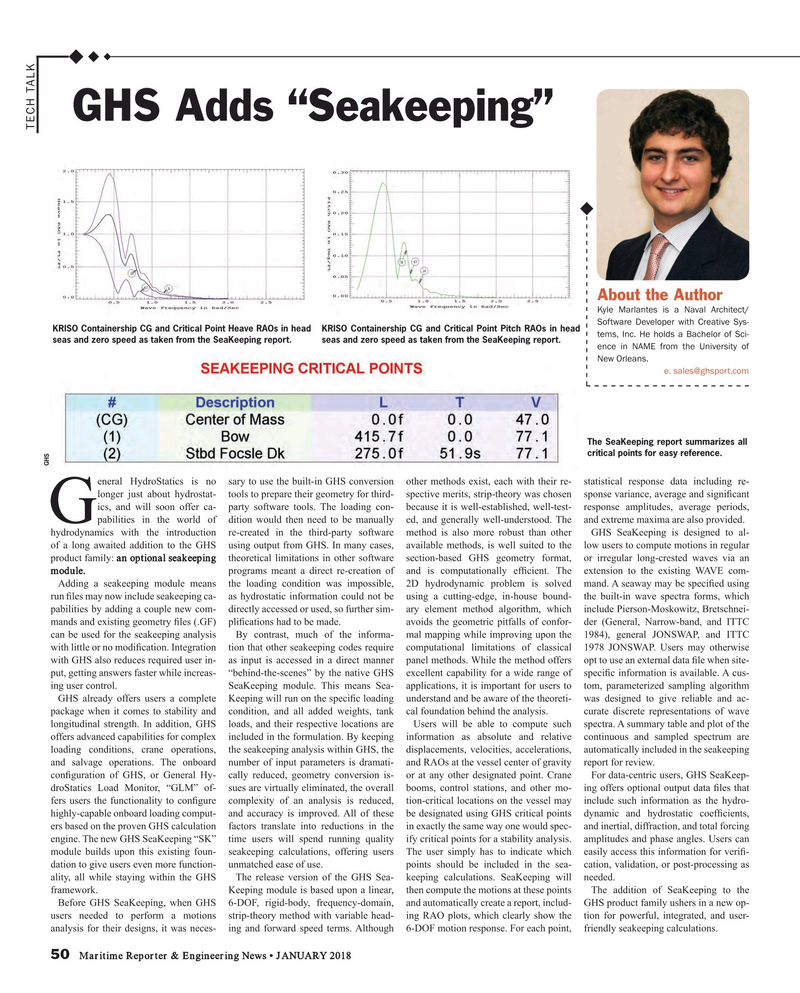
Page 50: of Maritime Reporter Magazine (January 2018)
Ship Repair & Conversion
Read this page in Pdf, Flash or Html5 edition of January 2018 Maritime Reporter Magazine
GHS Adds “Seakeeping”
TECH TALK
About the Author
Kyle Marlantes is a Naval Architect/
Software Developer with Creative Sys-
KRISO Containership CG and Critical Point Heave RAOs in head KRISO Containership CG and Critical Point Pitch RAOs in head tems, Inc. He holds a Bachelor of Sci- seas and zero speed as taken from the SeaKeeping report. seas and zero speed as taken from the SeaKeeping report.
ence in NAME from the University of
New Orleans. e. [email protected]
The SeaKeeping report summarizes all critical points for easy reference.
GHS eneral HydroStatics is no sary to use the built-in GHS conversion other methods exist, each with their re- statistical response data including re- longer just about hydrostat- tools to prepare their geometry for third- spective merits, strip-theory was chosen sponse variance, average and signi? cant ics, and will soon offer ca- party software tools. The loading con- because it is well-established, well-test- response amplitudes, average periods, pabilities in the world of dition would then need to be manually ed, and generally well-understood. The and extreme maxima are also provided.
G hydrodynamics with the introduction re-created in the third-party software method is also more robust than other GHS SeaKeeping is designed to al- of a long awaited addition to the GHS using output from GHS. In many cases, available methods, is well suited to the low users to compute motions in regular product family: an optional seakeeping theoretical limitations in other software section-based GHS geometry format, or irregular long-crested waves via an module. programs meant a direct re-creation of and is computationally ef? cient. The extension to the existing WAVE com-
Adding a seakeeping module means the loading condition was impossible, 2D hydrodynamic problem is solved mand. A seaway may be speci? ed using run ? les may now include seakeeping ca- as hydrostatic information could not be using a cutting-edge, in-house bound- the built-in wave spectra forms, which pabilities by adding a couple new com- directly accessed or used, so further sim- ary element method algorithm, which include Pierson-Moskowitz, Bretschnei- mands and existing geometry ? les (.GF) pli? cations had to be made. avoids the geometric pitfalls of confor- der (General, Narrow-band, and ITTC can be used for the seakeeping analysis By contrast, much of the informa- mal mapping while improving upon the 1984), general JONSWAP, and ITTC with little or no modi? cation. Integration tion that other seakeeping codes require computational limitations of classical 1978 JONSWAP. Users may otherwise with GHS also reduces required user in- as input is accessed in a direct manner panel methods. While the method offers opt to use an external data ? le when site- put, getting answers faster while increas- “behind-the-scenes” by the native GHS excellent capability for a wide range of speci? c information is available. A cus- ing user control. SeaKeeping module. This means Sea- applications, it is important for users to tom, parameterized sampling algorithm
GHS already offers users a complete Keeping will run on the speci? c loading understand and be aware of the theoreti- was designed to give reliable and ac- package when it comes to stability and condition, and all added weights, tank cal foundation behind the analysis. curate discrete representations of wave longitudinal strength. In addition, GHS loads, and their respective locations are Users will be able to compute such spectra. A summary table and plot of the offers advanced capabilities for complex included in the formulation. By keeping information as absolute and relative continuous and sampled spectrum are loading conditions, crane operations, the seakeeping analysis within GHS, the displacements, velocities, accelerations, automatically included in the seakeeping and salvage operations. The onboard number of input parameters is dramati- and RAOs at the vessel center of gravity report for review.
con? guration of GHS, or General Hy- cally reduced, geometry conversion is- or at any other designated point. Crane For data-centric users, GHS SeaKeep- droStatics Load Monitor, “GLM” of- sues are virtually eliminated, the overall booms, control stations, and other mo- ing offers optional output data ? les that fers users the functionality to con? gure complexity of an analysis is reduced, tion-critical locations on the vessel may include such information as the hydro- highly-capable onboard loading comput- and accuracy is improved. All of these be designated using GHS critical points dynamic and hydrostatic coef? cients, ers based on the proven GHS calculation factors translate into reductions in the in exactly the same way one would spec- and inertial, diffraction, and total forcing engine. The new GHS SeaKeeping “SK” time users will spend running quality ify critical points for a stability analysis. amplitudes and phase angles. Users can module builds upon this existing foun- seakeeping calculations, offering users The user simply has to indicate which easily access this information for veri? - dation to give users even more function- unmatched ease of use. points should be included in the sea- cation, validation, or post-processing as ality, all while staying within the GHS The release version of the GHS Sea- keeping calculations. SeaKeeping will needed.
framework. Keeping module is based upon a linear, then compute the motions at these points The addition of SeaKeeping to the
Before GHS SeaKeeping, when GHS 6-DOF, rigid-body, frequency-domain, and automatically create a report, includ- GHS product family ushers in a new op- users needed to perform a motions strip-theory method with variable head- ing RAO plots, which clearly show the tion for powerful, integrated, and user- analysis for their designs, it was neces- ing and forward speed terms. Although 6-DOF motion response. For each point, friendly seakeeping calculations.
50 Maritime Reporter & Engineering News • JANUARY 2018
MR #1 (50-57).indd 50 MR #1 (50-57).indd 50 1/9/2018 12:45:43 PM1/9/2018 12:45:43 PM

 49
49

 51
51
